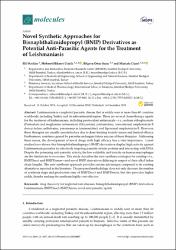| dc.contributor.author | Keskin, Elif | |
| dc.contributor.author | Üçışık, Mehmet Hikmet | |
| dc.contributor.author | Sucu, Bilgesu Onur | |
| dc.contributor.author | Güzel, Mustafa | |
| dc.date.accessioned | 2020-02-27T08:30:32Z | |
| dc.date.available | 2020-02-27T08:30:32Z | |
| dc.date.issued | 2019 | en_US |
| dc.identifier.citation | Keskin, E., Üçışık, M. H., Sucu, B. O. ve Güzel, M. (2019). Novel synthetic approaches for bisnaphthalimidopropyl (BNIP) derivatives as potential anti-parasitic agents for the treatment of leishmaniasis. Molecules, 24(24). http://doi.org/10.3390/molecules24244607 | en_US |
| dc.identifier.issn | 1420-3049 | |
| dc.identifier.uri | http://doi.org/10.3390/molecules24244607 | |
| dc.identifier.uri | https://hdl.handle.net/20.500.12511/4966 | |
| dc.description.abstract | Leishmaniasis is a neglected parasitic disease that is widely seen in more than 60 countries worldwide, including Turkey and its subcontinental region. There are several chemotherapy agents for the treatment of leishmaniasis, including pentavalent antimonials-i.e., sodium stibogluconate (Pentostan) and meglumine antimoniate (Glucantim), pentamidine, conventional amphotericin B deoxycholate, miltefosine, paramomycin (aminosidine), and liposomal amphotericin B. However, these therapies are usually unsatisfactory due to dose-limiting toxicity issues and limited efficacy. Furthermore, resistance gained by parasites endangers future success of these therapies. Addressing these issues, the development of novel drugs with high efficacy has a vital importance. Latest studies have shown that bisnaphthalimidopropyl (BNIP) derivatives display high activity against Leishmaniasis parasites by selectively targeting parasitic sirtuin proteins and interacting with DNA. Despite the promising anti-parasitic activity, the low solubility and toxicity on human macrophages are the limitations to overcome. This study describes the new synthesis strategies for existing-i.e., BNIPDaoct and BNIPDanon-and novel BNIP derivatives differing in respect of their alkyl linker chain lengths. The new synthesis approach provides certain advantages compared to its existing alternatives reported in the literature. The proposed methodology does not only decrease the number of synthesis steps and production time of BNIPDaoct and BNIPDanon, but also provides higher yields, thereby making the synthesis highly cost-effective. | en_US |
| dc.language.iso | eng | en_US |
| dc.publisher | MDPI | en_US |
| dc.rights | info:eu-repo/semantics/openAccess | en_US |
| dc.rights | Attribution 4.0 International | * |
| dc.rights.uri | https://creativecommons.org/licenses/by/4.0/ | * |
| dc.subject | Drug Discovery For Neglected Rare Diseases | en_US |
| dc.subject | Bisnaphthalimidopropyl (BNIP) Derivatives | en_US |
| dc.subject | Leishmaniasis | en_US |
| dc.subject | Bnipdaoct | en_US |
| dc.subject | Bnipdanon | en_US |
| dc.subject | Novel Anti-Parasitic Agents | en_US |
| dc.title | Novel synthetic approaches for bisnaphthalimidopropyl (BNIP) derivatives as potential anti-parasitic agents for the treatment of leishmaniasis | en_US |
| dc.type | article | en_US |
| dc.relation.ispartof | Molecules | en_US |
| dc.department | İstanbul Medipol Üniversitesi, Rektörlük, Rejeneratif ve Restoratif Tıp Araştırmaları Merkezi (REMER) | en_US |
| dc.department | İstanbul Medipol Üniversitesi, Mühendislik ve Doğa Bilimleri Fakültesi, Biyomedikal Mühendisliği Bölümü | en_US |
| dc.department | İstanbul Medipol Üniversitesi, Sağlık Hizmetleri Meslek Yüksekokulu, Eczane Hizmetleri Ana Bilim Dalı | en_US |
| dc.department | İstanbul Medipol Üniversitesi, Uluslararası Tıp Fakültesi, Temel Tıp Bilimleri Bölümü, Tıbbi Biyokimya Ana Bilim Dalı | en_US |
| dc.authorid | 0000-0001-9434-3861 | en_US |
| dc.authorid | 0000-0002-1423-0435 | en_US |
| dc.identifier.volume | 24 | en_US |
| dc.identifier.issue | 24 | en_US |
| dc.relation.tubitak | info:eu-repo/grantAgreement/TUBITAK/SOBAG/115Z846 | |
| dc.relation.publicationcategory | Makale - Uluslararası Hakemli Dergi - Kurum Öğretim Elemanı | en_US |
| dc.identifier.doi | 10.3390/molecules24244607 | en_US |
| dc.identifier.wosquality | Q2 | en_US |
| dc.identifier.scopusquality | Q1 | en_US |



















